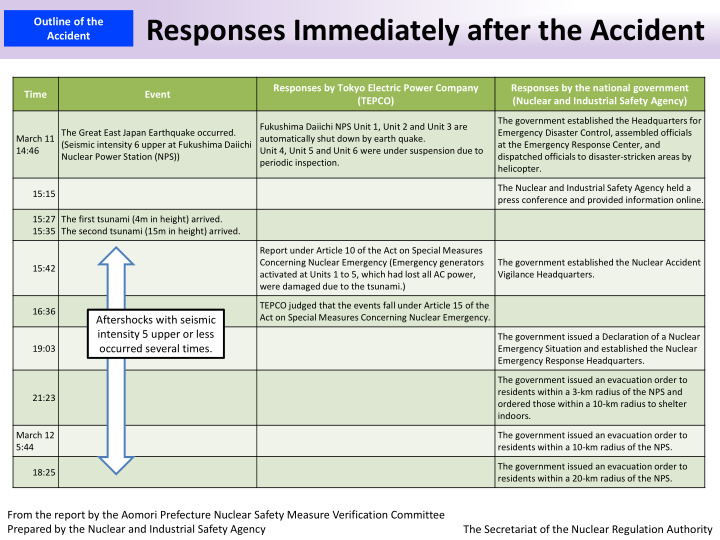



Responses Immediately after the Accident Outline of the Accident Responses by Tokyo Electric Power Company Responses by the national government Time Event (TEPCO) (Nuclear and Industrial Safety Agency) The government established the Headquarters for Fukushima Daiichi NPS Unit 1, Unit 2 and Unit 3 are The Great East Japan Earthquake occurred. Emergency Disaster Control, assembled officials March 11 automatically shut down by earth quake. (Seismic intensity 6 upper at Fukushima Daiichi at the Emergency Response Center, and 14:46 Unit 4, Unit 5 and Unit 6 were under suspension due to Nuclear Power Station (NPS)) dispatched officials to disaster‐stricken areas by periodic inspection. helicopter. The Nuclear and Industrial Safety Agency held a 15:15 press conference and provided information online. 15:27 The first tsunami (4m in height) arrived. 15:35 The second tsunami (15m in height) arrived. Report under Article 10 of the Act on Special Measures Concerning Nuclear Emergency (Emergency generators The government established the Nuclear Accident 15:42 activated at Units 1 to 5, which had lost all AC power, Vigilance Headquarters. were damaged due to the tsunami.) TEPCO judged that the events fall under Article 15 of the 16:36 Act on Special Measures Concerning Nuclear Emergency. Aftershocks with seismic intensity 5 upper or less The government issued a Declaration of a Nuclear occurred several times. 19:03 Emergency Situation and established the Nuclear Emergency Response Headquarters. The government issued an evacuation order to residents within a 3‐km radius of the NPS and 21:23 ordered those within a 10‐km radius to shelter indoors. March 12 The government issued an evacuation order to 5:44 residents within a 10‐km radius of the NPS. The government issued an evacuation order to 18:25 residents within a 20‐km radius of the NPS. From the report by the Aomori Prefecture Nuclear Safety Measure Verification Committee Prepared by the Nuclear and Industrial Safety Agency The Secretariat of the Nuclear Regulation Authority
Ambient Dose Rates during Two Months after the Accident Outline of the (Within and around of the premises of the Tokyo Electric Power Company (TEPCO)’s Accident Fukushima Daiichi Nuclear Power Station (NPS)) Hydrogen explosions occurred at buildings, etc. at Unit 1 to Unit 4 and the highest dose rates were measured in the morning of March 15. Highest dose rate at the main gate at 9:00 a.m. on March 15: 11,930μSv/h Near Radiation Monitoring Post‐4 (i) < Highest dose rates > (monitoring car) Near the main gate (monitoring car) (i) 9:00 a.m. on March 15 (Unit 4 Reactor Building damaged around 6:00 a.m. to 6:10 a.m.) Beside the gymnasium (monitoring car) (ii) 23:30 p.m. on March 15 (rain from around 23:30 p.m.) (iii) Radiation Monitoring Post‐5 (near the (iii) 12:30 p.m. on March 16 (steam from 3uR/B was confirmed around 8:30 west gate; monitoring car) North of the main office building a.m.) (monitoring car) (iv) 18:30 p.m. on March 21 (black smoke from 3uR/B was confirmed around South of the main office building (mobile 16:00 p.m.) dosimeter) Main gate (mobile dosimeter) (v) 13:20 p.m. on March 24 (steam from the roof of 1uR/B was confirmed around 10:50 a.m.) West gate (mobile dosimeter) (ii) Dose rate (μSv/h) (v) 15:00 p.m. on March 12: Hydrogen explosion at Unit 1 building 11:00 a.m. on March 14: Hydrogen explosion at Unit 3 building (iv) 6:00 a.m. on March 15: Hydrogen explosion at Unit 4 building Report of Japanese Government to the IAEA Ministerial Conference on Nuclear Safety, June 2011 Nuclear Emergency Response Headquarters, Attachment V‐9 μSv/h: micro sievert per hour The Secretariat of the Nuclear Regulation Authority
Ambient Dose Rates during Two Weeks after the Accident Outline of the (Within and around of the premises of the Tokyo Electric Power Company (TEPCO)’s Accident Fukushima Daiichi Nuclear Power Station (NPS)) ● Changes in ambient dose rates measured by monitoring cars within and around the NPS Near Radiation Monitoring Post (MP)‐4 Near the main gate Beside the gymnasium MP‐5 North of the main office building Vent operation at Unit 1 from 14:30 p.m. on March 12 Mobile MP (main gate) Explosion at Unit 1 building at 15:36 p.m. on March 12 Mobile MP (west gate) Vent operation at Unit 3 from 9:10 a.m. to 9:24 a.m. on March 13 Vent operation at Unit 3 from 12:30 p.m. on March 13 Vent operation at Unit 3 from 5:20 p.m. on March 14 Explosion at Unit 3 building at 11:01 a.m. on March 14 Vent operation at Unit 3 from 16:05 p.m. on March 15 Date Additional Report of the Japanese Government to the IAEA ‐ The Accident at TEPCO's Fukushima Nuclear Power Stations ‐ (Second Report) μSv/h: micro sievert per hour The Secretariat of the Nuclear Regulation Authority
International Nuclear Event Scale (INES) Outline of the Accident Level Accident examples Former Soviet Union: Chernobyl Nuclear Power Plant accident (1986) 7 Japan: Tokyo Electric Power Company (TEPCO)'s Fukushima Daiichi Nuclear Major accident Power Station (NPS) accident (2011) 6 Accident Provisionally evaluated as Level 7 on April 12, 2011 Serious accident 5 UK: Windscale Nuclear Power Plant fire accident (1957) Accident with wider US: Three Mile Island Nuclear Power Plant accident (1979) consequences 4 Japan: JCO criticality accident (1999) Accident with local France: Saint‐Laurent Nuclear Power Plant accident (1980) consequences Abnormal incident 3 Spain: Fire at Vandellos Nuclear Power Plant (1989) Serious incident 2 Japan: Damage to steam generator heat exchanger tube at Unit 2, Mihama NPS (1991) Incident Japan: Sodium leak accident at Monju (1995) 1 Japan: Primary coolant leak at Unit 2, Tsuruga NPS (1999) Japan: Pipe rupture in the residual heat removal system at Unit 1, Hamaoka NPS (2001) Anomaly Japan: Pipe failure in the secondary system at Unit 3, Mihama NPS (2004) 0 Below scale (No safety significance) Below scale Not covered (Events unrelated to safety) Prepared based on "The International Nuclear and Radiological Event Scale User's Manual" (IAEA) and "Report of Japanese Government to the IAEA Ministerial Conference on Nuclear Safety" (June 2011; Nuclear Emergency Response Headquarters)
Recommend
More recommend